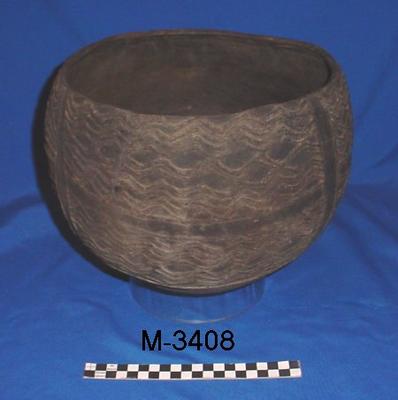Pottery
Country
Papua New Guinea
State/Province
Oro (Northern Province)
See full details
Object detail
Description
Earthenware Pot - BABIAF: e.w. network of dentated ridges
Classification
INDIGENOUS CULTURES Melanesian & South Sea Islander pottery
Measurements
H.245 x Dia.307 mm
Media/Materials description
Earthenware
History and use
A distinctive type of pottery is made at what is commonly referred to as 'Wanigela'. Wanigela consists of an area of land on the coast of Collingwood Bay between Cape Nelson to the north and Cape Vogel to the south. Pots are produced by women from the Austronesian-speaking coastal villages of Oreresan (Arifama-Miniafa language), Rainu and Komabun (Ubir language) and the inland non-Austronesian villages of Koreaf and Naukwate (Onjob language) and even with the variety in languages; the tradition of pot making is the same.
Pots are traded with people from further inland for feathers, reptile skins and tapa cloth. As well, pots are traded with people who live along Collingwood Bay, in return for Fergusson Island obsidian, shells and canoes.
This particular cooking pot, babiaf, is used for general cooking. Spherical with a round to slightly flattened base and restricted simple form, babiaf are about 22cm in height, with an approximate 24cm diameter. Wanigela pots are quite popular due to their even thickness and because their thin walls enable food to be cooked quickly.
The word for clay is naukwat and is collected and brought back to the village and is stored and covered with a damp cloth. Equipment used in the manufacture of pots include a thin board or mat on which to support the vessel, a damaged pot to hold the water, a beater and a variety of shells which are to be used for cutting, shaping, smoothing and decorating.
To begin with, a thick column (or pug) of prepared clay is stood upright on a support and the potter stands above it and then proceeds to push the clay down from the sides of the pug with her thumbs, forming a thick roll of clay around its base. The base is then scraped out and up, forming a flat-bottomed, straight sided dish shape, with the pug remaining in the centre. A piece from the top of the pug is then pinched off and rolled into a coil. The coil is then laid down inside the dish around the pug, and the wet end is placed against the top inside edge of the pot and coiled (or ringed) around the inside of the pot. After the coils have been pressed into place, the potter will utilise various shells to scrape the outside and inside with a shell, smooth down the walls and to cut off any unnecessary clay. The pot is then left alone for a few hours before being decorated. Following decoration, the pot is left to harden before having its sides beaten and rounded with a paddle. Completed pots are then left to dry for a few weeks before being fired and then smoked for a few more weeks after that before use.
Uploaded to the Web 27 May 2011.
Pots are traded with people from further inland for feathers, reptile skins and tapa cloth. As well, pots are traded with people who live along Collingwood Bay, in return for Fergusson Island obsidian, shells and canoes.
This particular cooking pot, babiaf, is used for general cooking. Spherical with a round to slightly flattened base and restricted simple form, babiaf are about 22cm in height, with an approximate 24cm diameter. Wanigela pots are quite popular due to their even thickness and because their thin walls enable food to be cooked quickly.
The word for clay is naukwat and is collected and brought back to the village and is stored and covered with a damp cloth. Equipment used in the manufacture of pots include a thin board or mat on which to support the vessel, a damaged pot to hold the water, a beater and a variety of shells which are to be used for cutting, shaping, smoothing and decorating.
To begin with, a thick column (or pug) of prepared clay is stood upright on a support and the potter stands above it and then proceeds to push the clay down from the sides of the pug with her thumbs, forming a thick roll of clay around its base. The base is then scraped out and up, forming a flat-bottomed, straight sided dish shape, with the pug remaining in the centre. A piece from the top of the pug is then pinched off and rolled into a coil. The coil is then laid down inside the dish around the pug, and the wet end is placed against the top inside edge of the pot and coiled (or ringed) around the inside of the pot. After the coils have been pressed into place, the potter will utilise various shells to scrape the outside and inside with a shell, smooth down the walls and to cut off any unnecessary clay. The pot is then left alone for a few hours before being decorated. Following decoration, the pot is left to harden before having its sides beaten and rounded with a paddle. Completed pots are then left to dry for a few weeks before being fired and then smoked for a few more weeks after that before use.
Uploaded to the Web 27 May 2011.
Registration number
MAC3408



